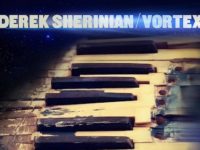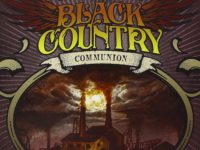There are records that are frankly too loud to be jazz, and swing too much to be rock. This is the slot for those things — a place where you’ll find everyone from Tony Levin and Derek Sherinian from Black Country Communion to Nels Cline and Bill Frisell.
Click through the titles for complete reviews …
No. 10—
NELS CLINE, TIM BERNE AND JIM BLACK – THE VEIL: A mind-bending amalgam of free jazz, guitar improvisation, textural sounds and eye-popping funk experiments, The Veil is as weird as it is melodically involving as it is (no kidding) sometimes sweetly lyrical. Credit this supergroup configuration out of New York City for hurtling us toward a lights-out, car-smashing intersection of jazz, alternative rock, and electronica. “This is one of those aberrant trios where the odd combination of sax (Berne), electric guitar (Cline) and drums/laptop effects (Black) make not only a cacophony, but a cacophony of a different sort: Where jazz dares not tread because it’s too brutal, and rock won’t go there either because it’s too unpredictable and tortuous,” our S. Victor Aaron says. Skronky, swinging, heavy and then almost ambient at times, this live project documents three improvisational giants at the top of their game.
No. 9—
PAT METHENY – WHAT IT’S ALL ABOUT: It was, on its face, a hard one to get excited about. We had Metheny redoing songs that were in the Top 40 during his teen years, including such bedraggled pop tunes as “The Sound of Silence,” “Slow Hot Wind,” “The Girl from Ipanema,” “And I Love Her,” and “Betcha By Golly Wow.” Great songs in their time, to be sure. But undead old saws by now — played to death, and then some. Even “Alfie’s Theme,” thanks to a game-changing reinterpretation by Sonny Rollins, has become rote. Yet, the format here — typically, Metheny recorded alone, on his custom baritone guitar — added a twilight poignancy. As Mark Saleski says: “This isn’t just Pat turning out well-behaved versions of vintage pop tunes; it is, instead, a tour of Metheny’s pop music past by way of his entire career’s arc.” By the end, this album moved well beyond its adult-listening trappings and into real emotional revelation, feeling less like a private rumination than a very public celebration of Metheny’s more mainstream influences.
NO. 8—
MATT GERAGHTY PROJECT – DEPARTURES: This self-produced album, an intriguing experiment with world music, found Geraghty focusing (sometimes loosely) on a travel theme. It’s entirely appropriate, too, since so much of the album was a departure from expectations for so-called contemporary jazz: Geraghty opened with a short instrumental piece featuring the sarangi, a bowed stringed instrument from North India, before a gentle piano interlude seemed to point back toward more familiar waters. Not so fast: Ara Dinkjian leapt to the fore with turns on the cumbus and oud, stringed instruments from Turkey and North Africa, respectively — and the stage was set. For all of its experimentation with exoticism, however, Departures retained a rare listenability. Geraghty is as interesting as he is approachable, something that draws even the uninitiated deeply into these new sounds.
No. 7—
LARRY CORYELL – WITH THE WIDE HIVE PLAYERS: A bracing return to the sizzling bop-meets-soul fusion sound of Coryell’s early years. As our S. Victor Aaron said: “Coryell fans might think this is a follow-up to Offering or that first Eleventh House album, and to a large degree it is. All the earmarks from his signature style from that era are there.” That means this collaboration with a Bay Area-based rhythm and horn section skipped past the hard rock and prog influences that began to dominate jazz rock in the 1970s, all the way back to the genre’s earliest beginnings — a soulful stew of bell-bottomed single-note lines, burping brass blasts and grease-popping attitude. Groovy, baby!
No. 6—
DEREK SHERINIAN – OCEANA: Sherinian, known for his work both with Black Country Communion and Dream Theater, is a keyboardist. It’s worth repeating, under your breath, as this guitar-heavy project unfolded, each cut adding layer upon layer of heavy fusion — at times, even, sounding like math metal. Maybe it’s no surprise, checking the liner notes. Featured guest guitarists included Toto’s Steve Lukather (on three tracks), Tony MacAlpine of Planet X (on two), Steve Stevens of Billy Idol fame (on two) and Joe Bonamassa (a bandmate of Sherinian’s in Black Country Communion). Still, Sherinian, who made his bones playing with superstars like former Jimi Hendrix collaborator Buddy Miles, Alice Cooper and Kiss, never got lost despite the star power -– even though any of those talents, in their own way, could have easily taken over the record. Instead, Sherinian was both a canny accompanist (when he needed to be), and an involving improviser. Together, they fashioned one of the guitar-rockingest keyboardist-led projects of the year. A fast-moving thrill.
No. 5—
JACOB FRED JAZZ ODYSSEY – THE RACE RIOT SUITE: A robustly complex, bluntly political statement, and deeply involving experience — and all the more remarkable for having sprung from the creative imaginations of the Jacob Fred Jazz Odyssey, a long-time darling of the jam band and indie rock set. Stunned by the revelation of their hometown’s draconian response to an early 1900s-era riot in Tulsa, Oklahoma — incendiary bombs dropped by airplane sparked a fire that burned out dozens of city blocks — the band was moved to retell this all-but-forgotten tale. The results, both musically and spiritually challenging, went beyond describing racism’s devastating effects: Race Riot, conceived, written and arranged by the band’s lap steel guitarist Chris Combs, challenges us all to confront the deeper, darker places within our own hearts. At the same time, the album allows for an emotional rebirth, as it celebrates both the resiliency and faith that carries us through adversity.
No. 4—
RAOUL BJORKENHEIM, BILL LASWELL AND MORGAN AGREN – BLIXT: Sounding something like neo-prog meets outjazz, this project was just as interesting for what it did as what it didn’t do. Sure, there were the considerable joys of their ear-melting inferno “Black Whole,” the opening cut on Blixt, but this power trio is also more than capable of downshifting into brilliantly coiled moments like “Shifting Sands Closing Hour,” with its mysterious far-east feel. They dashed through the rumbling angular mysteries of “Moon Tune,” but also boldly explored a gangly conspiratorial twilight in “Invisible One.” In the end, they fashioned an album of muscular inventiveness — often played hard, and sometimes quite fast — but one that never got too far afield from the nuances and textures that gave Blixt its creative heft.
No. 3—
REZ ABBASI’S INVOCATION – SUNO SUNO: There was a trance-like euphoria surrounding this emotional, at times indescribably spiritual endeavor. Abbasi, leading a group that also includes Rudresh Mahanthappa and Vijay Iyer, found inspiration here from Pakistani Qawwali, a devotional Sufi music. As with traditional gospel music, Qawwali is often populated with heart-filling themes of uplift, but it also includes these thrillingly circular, repeated melodies — something that give Abbasi’s music passion and joy, but also this enthralling, almost hypnotic power. Qawwali is the jumping off point, though, not the end point. From there, Invocation set about concocting a stirring new hybrid, one that strongly underlined the lasting influence of John Coltrane — especially in the way this group often worked toward an almost unbridled release without losing musical coherence.
No. 2—
LEVIN TORN WHITE – LEVIN TORN WHITE: Part prog, part free-form improvisational music, part noise rock, this album brought in each of its participant’s familiar textures and sounds, yet ended up somehow as something completely new. Tony Levin, David Torn and Alan White got there by building off live jams, with volume and distortion serving almost as additional members of the trio — something Levin talked about with us: “Good question about the distortion. There was a lot of it on this project. My opinion is that we just hear what the music is like, then respond the way our musical sense tells us to. In this case, it was with some heavy, gritty sounds. It wasn’t a plan at all; just the way the music took us.” We were happy to have been along for the ride — an often very boisterous, seatbelt-stretching ride.
No. 1—
BILL FRISELL – ALL WE ARE SAYING: A lesser talent might have been too careful. Instead, the thing that made this album feel so connective was Frisell’s willingness to simply let things happen — to internalize these songs, each of them talismanic John Lennon classics, and then build off of them. That kept All We Are Saying from becoming trapped in its own history. There are times, in fact, when the underlying melodies, so familiar as to become rote, don’t bubble up until the song is well underway. While Frisell clearly bonds with the core emotions that each track initially held, he’s not afraid to move beyond the obvious template. The result is a collection of familiar tunes that nevertheless boasts this thrumming, ageless vibrancy.
2011 JAZZ ROCK AND FUSION JAZZ HONORABLE MENTIONS: Kidd Jordan’s On Fire draws a brilliantly conceived line between primal jazz and advanced jazz … Greg Ward’s piano-less experiment on Greg Ward’s Phonic Juggernaut turned into chance-taking triumph. … Human Element’s self-titled release was sent to new heights by the combined contribution of tribal vocals and compelling percussion by Arto Tuncboyaciyan. … Exegesis’ The Harmony of the Anomaly was like a jazzier King Crimson. … They’re called the Dead Kenny Gs. That would have been enough. But then they went and put out an album that’s as frankly nutty as it is brilliantly executed, Operation Long Leash.
- Nick DeRiso’s Best of 2015 (Rock + Pop): Death Cab for Cutie, Joe Jackson, Toto + Others - January 18, 2016
- Nick DeRiso’s Best of 2015 (Blues, Jazz + R&B): Boz Scaggs, Gavin Harrison, Alabama Shakes - January 10, 2016
- Nick DeRiso’s Best of 2015 (Reissues + Live): John Oates, Led Zeppelin, Yes, Faces + others - January 7, 2016




